Sony PCG-TR3A, PCG-TR3AP1, PCG-TR3AP2, PCG-TR3AP3, PCG-TR5AP User Guide

Welcome
Congratulations on your purchase of this Sony VAIO® computer, and welcome to the online VAIO® Computer User Guide. This user guide provides detailed information on all aspects of using your new VAIO computer, from keyboard functions to preinstalled software programs.
In the left navigation window, click the topics you want to learn more about, and that information will be displayed in this main window.
 View the Electronic Flyer, which provides updates and supplemental information about your computer.
View the Electronic Flyer, which provides updates and supplemental information about your computer.
 Go to the Sony Computing Support Web site to view the VAIO® Computer Specifications, which lists your computer's hardware specifications and preinstalled software information.
Go to the Sony Computing Support Web site to view the VAIO® Computer Specifications, which lists your computer's hardware specifications and preinstalled software information.
For Sony software information, click Start and select Welcome to VAIO Life.
Page 1

Caring for Your Computer
This section provides information on how to safely use your Sony computer.
Page 2
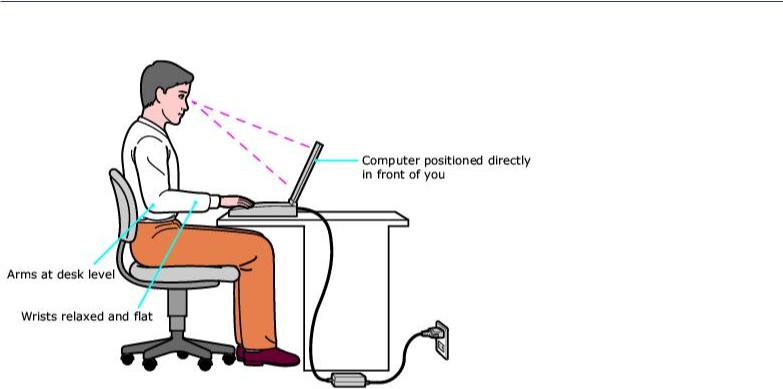
Applying Ergonomics
Your computer is a portable device and can be used in a variety of environments. Whenever possible, you should apply the following ergonomic considerations:
Position of your computer — Place the computer directly in front of you as you work. Keep your forearms horizontal, with your wrists in a neutral, comfortable position while using the keyboard, touch pad, or external mouse. Let your upper arms hang naturally at your sides. Take breaks during sessions with your computer. Excessive use of the computer may strain muscles or tendons.
Furniture and posture — Sit in a chair with good back support and armrests. Adjust the level of the chair so your feet are flat on the floor. A footrest may make you more comfortable. Sit in a relaxed, upright posture and avoid slouching forward or leaning far backward.
Viewing angle of the computer's display — Tilt the display to find the best viewing angle. Also try adjusting the brightness setting of the display. Following these suggestions can reduce eye strain and muscle fatigue.
Lighting — Choose a location where windows and lights do not create glare or reflection on the display. Use indirect lighting to avoid bright spots on the display. You can purchase accessories for your display that help reduce glare. Proper lighting adds to your comfort and work effectiveness.
Placement of an external display — When using an external display, set the display at a comfortable viewing distance. Make sure the display screen is at eye level or slightly lower when you are sitting in front of the monitor.
Page 3

Storing Your Computer
Do not use or store your computer in a location subject to:
Heat sources, such as radiators or air ducts
Direct sunlight
Excessive dust
Moisture or rain
Mechanical vibration or shock
Strong magnets or speakers that are not magnetically shielded
Ambient temperature higher than 95ºF (35ºC) or less than 40ºF (5ºC)
High humidity
Do not place electronic equipment near your computer. When running, the computer's electromagnetic field may cause other electronic equipment in close proximity to malfunction.
Provide adequate air circulation to prevent internal heat buildup. Do not place your computer on porous surfaces such as rugs or blankets, or near materials such as curtains or draperies that may block ventilation. Leave a space of at least 8 inches (20 cm) behind the back of the computer.
If the computer is brought directly from a cold location to a warm one, moisture may condense inside your computer. In this case, allow at least one hour before turning on your computer. If any problems occur, unplug your computer, and contact your Sony Service Center.
The computer uses high-frequency radio signals and may interfere with radio or TV reception. Should this occur, move the computer a suitable distance away from the radio or TV.
Do not drop the computer or place heavy objects on top of the computer.
Page 4

Using Cables and Connections
Use only specified peripheral equipment and interface cables.
Do not use cut or damaged connection cables.
If the telephone company makes a service call to your home or office and determines that your computer is responsible for a problem, the telephone company may bill you for the service call. Also, if you do not disconnect your computer when it is adversely affecting a telephone line, the telephone company has the right to disconnect your service until you correct the problem.
Page 5

Cleaning Your Computer
Clean the computer with a soft, dry cloth or a soft cloth lightly moistened with a mild detergent solution. Do not use any type of abrasive pad, scouring powder, or solvent such as alcohol or benzine, as these may damage the finish of your computer. You can use canned compressed air specifically for computers to remove dust.
If a solid object falls onto the computer or a liquid leaks into the computer, immediately turn off and unplug the computer. It is best to have the computer checked by qualified personnel before you use it again.
Avoid rubbing the LCD screen as this can damage the screen. Use a soft, dry cloth to wipe the LCD screen or canned compressed air.
Always disconnect the power cord before cleaning the computer.
Page 6
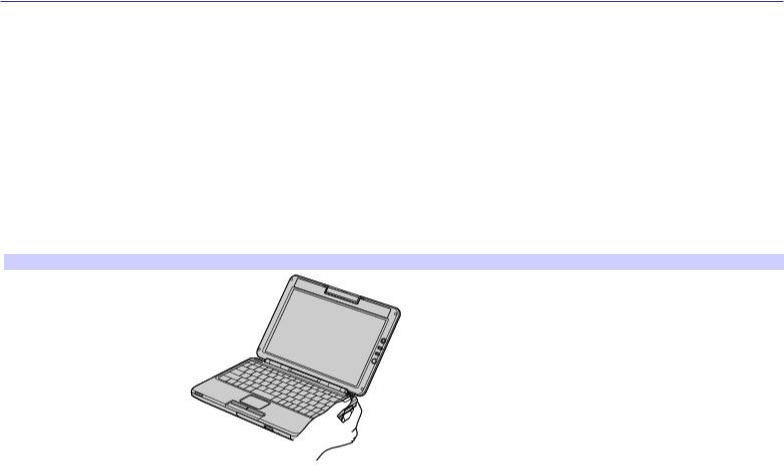
Handling the LCD Screen
Direct sunlight can damage the LCD. Be careful when using the computer near a window.
Do not scratch the LCD or exert pressure on it. This can cause a malfunction.
Using the computer in low temperature conditions may produce a residual image on the screen. This is not a malfunction. When the computer returns to normal temperature, the screen returns to normal.
The screen becomes warm during operation. This is normal and does not indicate a malfunction.
The LCD is manufactured using high-precision technology. You may, however, see tiny black points and/or bright points (red, blue, or green) that continuously appear on the LCD. This is a normal result of the manufacturing process and does not indicate a malfunction.
Handle the computer by its base to avoid damaging the LCD screen. Lifting the computer or exerting any kind of pressure to the edges of the LCD screen may damage it.
Handling the LCD Screen
Page 7

Powering Your Computer
Your VAIO® computer comes with a battery and an AC adapter. This chapter explains how to install and use these supplied accessories to power your computer. It also describes ways you can efficiently utilize the battery as a power source.
Page 8

Using AC Power
The supplied battery is not charged when you receive your computer. To charge the battery and begin using the computer immediately, insert the battery into the computer and use the supplied AC adapter as a power source. The computer automatically charges the installed battery while it uses AC power.
Page 9
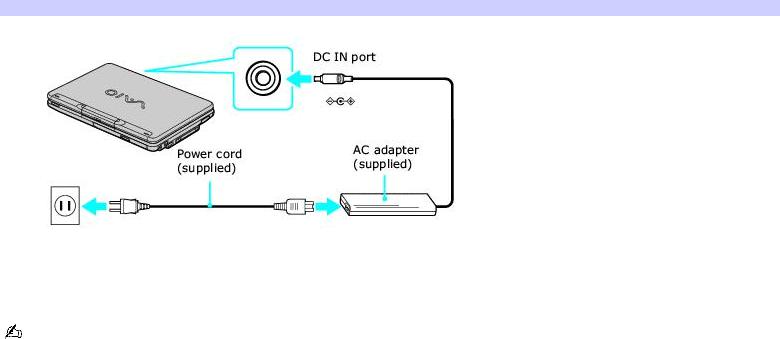
Connecting the AC adapter
To connect the AC adapter
1.Plug the AC adapter cable into the DC IN port.
Connecting the AC Adapter to the Computer
2.Plug the power cord into the AC adapter and an AC outlet.
Use only the supplied AC adapter with your computer.
Page 10
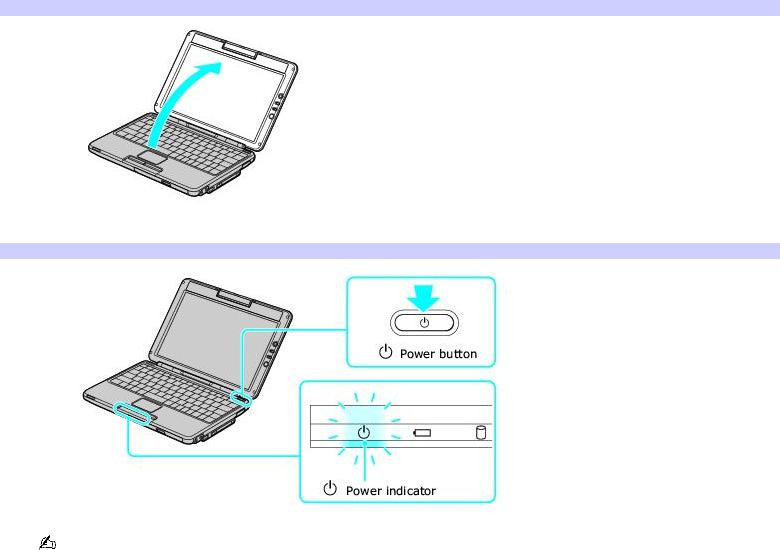
Turning on the computer
To open and turn on the computer
1.Lift the cover while holding the bottom of the computer firmly.
Opening the Computer
2.Press the power button until the power indicator turns on.
Turning on the Computer
If you continue to press the power button, the computer turns off.
3.If the computer screen is too dark or too bright, follow these steps to adjust the brightness:
To increase brightness, press the Fn and F5 keys, and then press the Up Arrow  or the Right Arrow
or the Right Arrow
 key.
key.
To decrease brightness, press the Fn and F5 keys, and then press the Down Arrow  or the Left Arrow
or the Left Arrow  key.
key.
Page 11

Using the Battery
Your computer, depending on the model you purchased, may come equipped with one battery bay and one multipurpose bay that supports a second battery. If your computer comes with two bays, you can purchase a second rechargeable battery to extend your computing time. For information on how to extend the life of the battery, see Conserving Battery Power for more information.
 The battery that comes with your computer is not fully charged at the time of purchase.
The battery that comes with your computer is not fully charged at the time of purchase.
 The brightness of your computer screen automatically dims when you switch from AC power to battery power. To increase the brightness, press the Fn and F5 keys, and then press the Up Arrow
The brightness of your computer screen automatically dims when you switch from AC power to battery power. To increase the brightness, press the Fn and F5 keys, and then press the Up Arrow  or Right Arrow
or Right Arrow  key.
key.
 For safety and/or optimum performance, Sony recommends using genuine Sony rechargeable battery packs.
For safety and/or optimum performance, Sony recommends using genuine Sony rechargeable battery packs.
Page 12

Inserting a battery
To insert a battery
1.Turn the computer over, and slide the UNLOCK/LOCK latch on the bottom of the computer to the UNLOCK position.
2.Align the tabs on the battery with the grooves on the back of the computer, and slide the battery into the computer until it clicks into place.
Inserting a Battery
3.Slide the UNLOCK/LOCK latch into the LOCK position to secure the battery.
Some programs and peripheral devices prevent the system from automatically entering Hibernate mode. If you are using battery power, save your data frequently to avoid data loss and manually activate a power saving mode. See Using power saving modes for more information.
Page 13
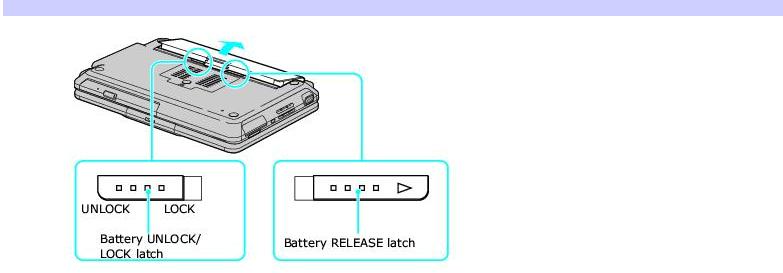
Removing a battery
If you are not using the computer for an extended period of time, remove the battery from the computer to avoid damaging the battery. Remove the battery when the computer is off.
To remove a battery
1.Make sure the computer is off.
2.Turn the computer over, and slide the UNLOCK/LOCK latch on the bottom of the computer to the UNLOCK position.
3.Push and hold the RELEASE latch.
4.While holding the RELEASE latch, slide the battery away from the computer.
Removing a Battery
Page 14
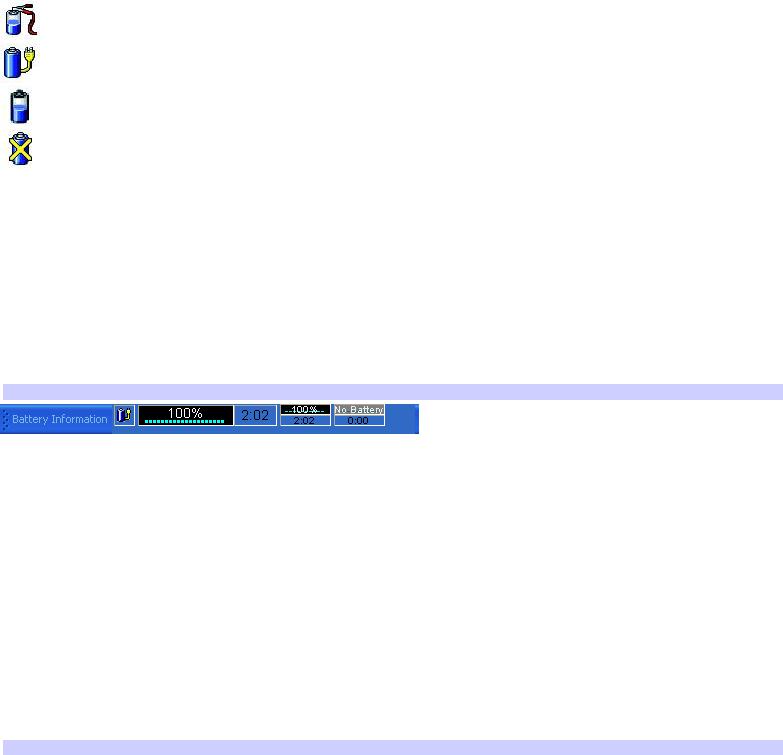
Locating battery information
You can view the remaining battery charge and miscellaneous battery information on the Battery Information toolbar, the PowerProfile window, and the Power Meter window.
The Battery icons that appear on the Battery Information toolbar and PowerPanel window indicate the current status of the installed battery.
Battery icon Charge status
Charging
Fully charged
Discharging
No battery
To view the Battery Information toolbar
1.Right-click the center of the Windows® taskbar.
2.Select Toolbars from the shortcut menu, and click Battery Information. The Battery Information toolbar appears on the taskbar.
 If the Battery Information the Taskbar. Click and drag the
If the Battery Information the Taskbar. Click and drag the
toolbar is hidden behind the taskbar icons, right-click the taskbar and click to cancel Lock edge of the Battery Information toolbar to the left until it is in clear view.
The total charge remaining in the battery is listed in percent and real-time values.
Battery Information Toolbar*
* The Battery Information Toolbar may appear slightly different on your computer, depending on the number of batteries your computer supports.
Percentage indicator — Displays the percentage of the remaining charge.
Time indicator — Displays estimated time (hours : minutes) remaining before the battery fully discharges, also known as the time-to-empty.
To close the Battery Information toolbar
1.Right-click the Battery Information toolbar.
2.Select Toolbars from the shortcut menu, and click to cancel Battery Information. The Battery Information toolbar disappears from the taskbar.
To view the PowerPanel window
Double-click the CPU icon  or Profile icon
or Profile icon  , depending on the model you purchased. The PowerPanel window appears.
, depending on the model you purchased. The PowerPanel window appears.
PowerPanel*
Page 15
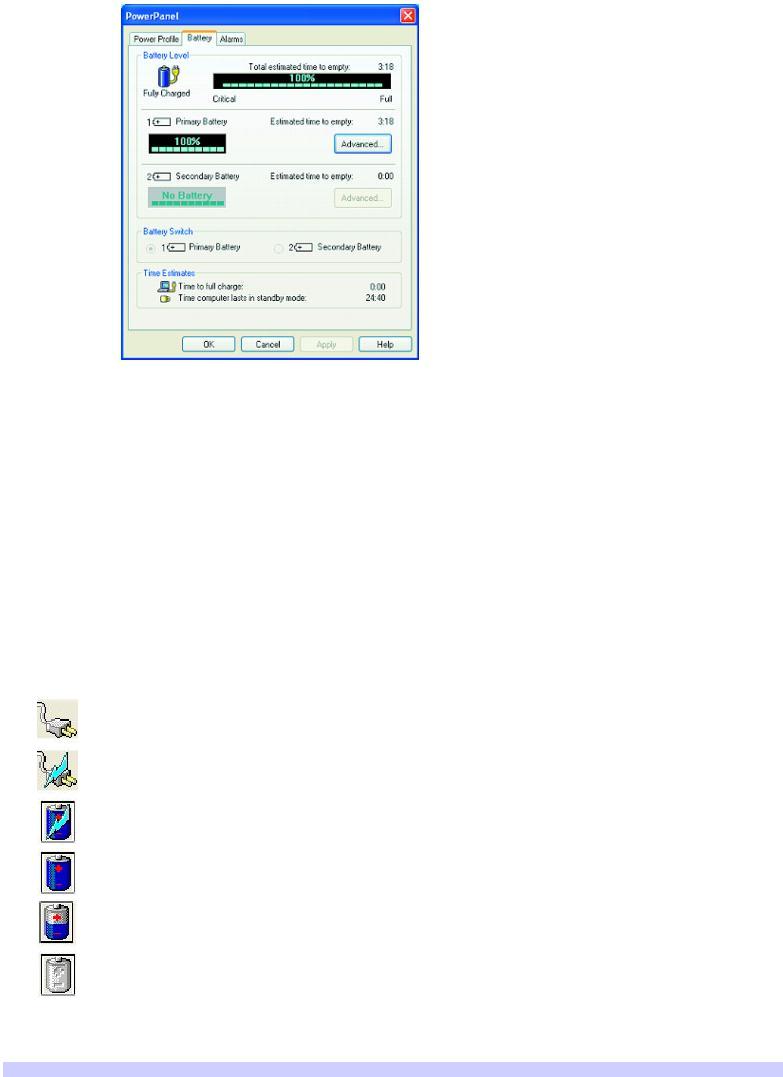
* The PowerPanel window may appear slightly different on your computer, depending on the number of batteries your computer supports.
Power Profile — Displays the power management settings for various devices on your system. You can change the settings to conserve power.
Battery tab — Displays the total charge remaining in the battery. You can click Advanced for specific information on the battery.
Alarms tab — Displays the alarm settings, which notify you when the battery is fully charged or too low. You can change your computer's alarm settings on this window.
 Click Help in the lower right corner of the window for more information.
Click Help in the lower right corner of the window for more information.
To view the Power Meter window
1.Double-click the Power icon. The Power Meter window appears. You can also rollover the Power icon to view the remaining battery charge.
Power icon |
Power status |
Computer is using AC power.
Computer is using AC power and charging the battery.
Battery is charging.
Battery is fully charged.
Battery is discharging.
No battery is inserted in the computer.
 If the Power icon is not displayed on the Taskbar Notification area, see To display the Power icon on the taskbar.
If the Power icon is not displayed on the Taskbar Notification area, see To display the Power icon on the taskbar.
Power Meter
Page 16

To display the Power icon on the taskbar
1.Click Start on the Windows® taskbar, and click Control Panel.
2.Click Performance and Maintenance, and click Power Options. The Power Options Properties window appears.
3.Select the Advanced tab, and then select Always show icon on the taskbar in the Options box. The Power icon appears on the taskbar. See the Power icon descriptions above for more information.
Page 17
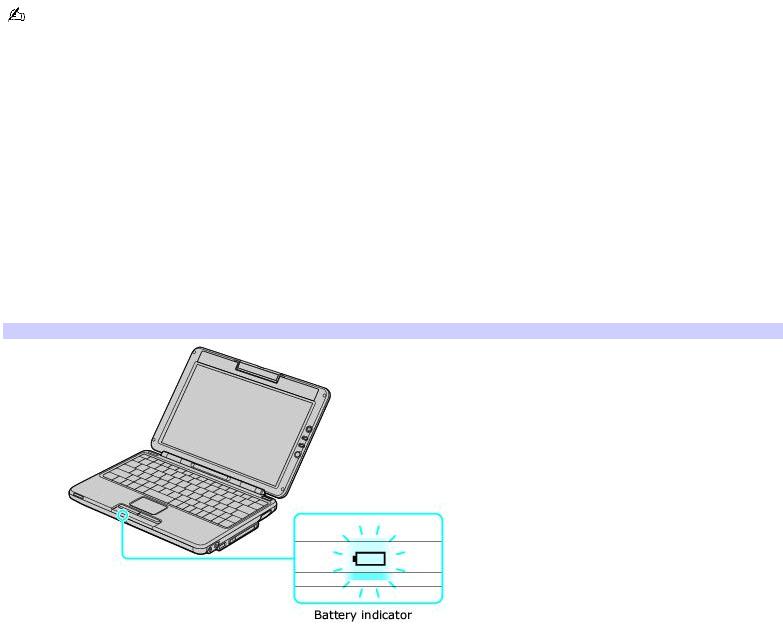
Charging a battery
You will need to charge the battery if battery power drops below 10 percent or you have not used the battery for a long time. The lithium-ion battery supplied with your computer may be recharged at any time, whether you wait until the battery is completely or partially discharged. Charging a partially discharged battery does not affect battery life. If you charge the battery and find that battery power is still low, the battery may be reaching the end of its life, and you may need to replace it.
The battery supplied with your computer is not charged at the time of purchase.
To charge a battery
You can charge the battery when the computer is on or off. However, the battery will charge faster when the computer is off. Charging the battery takes several hours. See your VAIO® Computer Specifications for the approximate time needed to charge your battery.
 Charge the battery at temperatures between 50°F and 80°F (10°C to 30°C). Lower temperatures require more time to charge.
Charge the battery at temperatures between 50°F and 80°F (10°C to 30°C). Lower temperatures require more time to charge.
1.Insert the battery into the battery bay.
2.Connect the AC adapter to the computer. The computer automatically charges the battery as long as the computer is using AC power.
The battery indicator blinks while the battery charges. The battery indicator stops blinking when the battery is fully charged.
Battery Indicator
Battery indicator status |
Description |
On |
The computer is using battery power. |
Single blink |
The battery is running out of power. |
Double blink |
The battery is charging. |
Off |
The computer is using AC power. |
Page 18
Notes on batteries
Never leave the battery in temperatures above 140°F (60°C), such as under direct sunlight or in a car parked in the sun.
While the battery is in use or being discharged, the battery heats up. This is normal and is not cause for concern.
Keep the battery away from heat sources.
Keep the battery dry.
Do not open or disassemble the battery.
Do not expose the battery to any mechanical shock.
Battery life is shorter in a cold environment because of decreased battery efficiency at low temperatures.
Page 19

Conserving Battery Power
You may use the power saving modes and PowerPanel utility to conserve battery power. Conserving battery power may significantly extend your computing time, depending on how you use your computer.
Page 20
Using power saving modes
In addition to the normal operating mode, which allows you to turn off specific devices to save power, your computer has two distinct power saving modes: Standby and Hibernate. Use the Standby and Hibernate power saving modes to override a power profile setting and initiate immediate action.
Standby — Saves the state of the system and peripheral devices in memory (RAM). The system remains on, and the computer screen (LCD) is off.
Hibernate — Saves the state of the system and peripheral devices to the hard disk. Hibernate mode consumes the lowest level of power. Your computer enters Hibernate mode when the remaining battery charge drops below 5 percent, regardless of the setting you select.
 Since some programs and peripheral devices prevent the system from entering Hibernate mode, save your data frequently to avoid data loss.
Since some programs and peripheral devices prevent the system from entering Hibernate mode, save your data frequently to avoid data loss.
To activate Standby mode
1.Press the Fn and Esc keys. The power indicator blinks in this mode.
2.Press any key to return to normal mode.
To activate Hibernate mode
1.Press the Fn and F12 keys, or press the power button and release it immediately. Do not move the computer until the power indicator turns off.
2.Press the power button to return to normal mode.
 If your computer does not activate Hibernate mode, see Battery for more information.
If your computer does not activate Hibernate mode, see Battery for more information.
Page 21

Using PowerPanel utility
The PowerPanel utility enables you to select and customize a predefined power management profile to conserve battery life. The following table describes all the predefined power management profiles in PowerPanel. You can customize the settings for all the following profiles, except the Disable Power Management profile.
Profile
Icon Description
 Maximum Performance
Maximum Performance
Provides the best system performance but conserves minimal power.
 Maximum Battery Life
Maximum Battery Life
Provides power saving features to give you maximum battery life and good performance. It slows the computer and puts it into Standby mode after a specified time.
Ultimate Battery Life1
Extends the Maximum Battery Life by stopping power to the optical drive and Memory Stick® media slot.
 Power Management Off
Power Management Off
Disables all power management settings, such as Standby and Hibernate modes. You cannot change the settings of this profile.
 AC Power
AC Power
Indicates when AC power is in use. Similar to Power Management Off and the Standby mode after a half hour. Power Management automatically loads the AC profile unless you disable this feature.
 Games
Games
Disables the display and the Hard Disk Standby timer.
 Presentation
Presentation
Keeps the display on at all times while conserving power. This option is ideal for slide show presentations. You can establish settings for LCD (Video) Standby, Hard Disk Standby, and Standby mode to optimize power management for your system.
 Camera
Camera
Optimizes performance and power requirements for camera usage.
DVD
Optimizes performance and power requirements for DVD usage.
 Word Processing
Word Processing
Optimizes power management with longer time-outs on the hard disk and display screen. You can also establish settings for LCD (Video) Standby, Hard Disk Standby, and Standby mode to optimize power management for your system.
 Spreadsheet
Spreadsheet
Optimizes performance and power requirements for spreadsheet programs.
 Communications
Communications
Extends battery life by initiating a quick display time-out. The Internal modem remains powered on. You can also establish settings for LCD (Video) Standby, Hard Disk Standby, and Standby mode to optimize power management for your system.
 Automatic Profile Selection
Automatic Profile Selection
Automatically selects a profile suitable for active software programs.
Page 22
1 Do not choose the A utomatic Profile Selection when connected to A C power.
To select a profile
1.Right-click the CPU icon  or Profile icon
or Profile icon  , depending on the model you purchased. See Locating battery information for Battery icon descriptions.
, depending on the model you purchased. See Locating battery information for Battery icon descriptions.
2.Select Profiles, and click the profile on the shortcut menu. The profile settings are implemented instantly. See Using PowerPanel utility for descriptions of available profiles.
When you use the battery to power your computer, your system automatically selects the Maximum Battery Life power management profile by default. If you select a different power management profile while using battery power, that profile is selected automatically the next time you use the battery to power your computer.
 See PowerPanel Help for information on customizing the power management profiles.
See PowerPanel Help for information on customizing the power management profiles.
To customize your profile settings
You can customize your profile settings to sustain enough power for a particular computing function.
1.Right-click the CPU icon  or Profile icon
or Profile icon  , depending on the model you purchased.
, depending on the model you purchased.
2.Select Edit/Create Profiles from the shortcut menu.
3.In the left panel, select the profile you want to change.
4.In the right panel, right-click the setting under System, LCD (Video), Hard Disk, or Other Devices that you want to change. See the following table for a description of each power management setting.
5.Make your changes from the drop-down menu.
6.Click File, and click Save.
Power Management Setting Description
CPU Control1 |
Controls the processor speed. You can select either Performance, Adaptive, or Battery Life. These |
selections are listed in order from the greatest to least amount of power consumed. |
|
Standby Timer |
Controls the time it takes the system to activate the Standby mode when it is idle. The longer you |
allow the computer to sit idle while it is not in a power saving mode the more power the computer consumes.
Hibernate
Timer Controls the time it takes the system to activate the Hibernate mode when it is idle. The longer you allow the computer to sit idle while it is not in a power saving mode the more power the computer consumes. Hibernate mode conserves more power than Standby mode.
CPU Fan Control1 |
(On selected models) Controls the speed of the processor fan. You can set the fan speed to different |
|
levels. Level 1 (Quiet) conserves the most power. |
||
Lid Close Action |
Controls the state of your system when the lid of the computer is closed. You can select either |
|
Standby, Hibernate, or LCD Off. |
||
Hibernate on Low Battery |
Controls the state of your system when the battery power is low. You can turn this setting |
|
On or Off. Selecting On conserves the most power when the battery is low.
LCD
Brightness Controls the brightness of the computer screen (LCD). You can select a brightness level of one to nine. The darker you set the computer screen the more power you conserve.
LCD Standby Timer Controls the time it takes the system to turn off power to the computer screen (LCD) when thePage 23
system is idle. The system itself still functions on full power.
HDD Standby Timer Controls the time it takes the system to turn off power to the hard disk drive when the system is idle. This setting only turns off power to the hard disk drive.
i.LINK Port |
(On selected models) Controls power to the i.LINK® port. Disabling power to the i.LINK port conserves |
|
power. |
|
|
Memory Stick Port Power-saving |
Controls power to the Memory Stick media slot. Disabling power to the Memory Stick |
|
media slot conserves power. |
|
|
Optical Drive Power-Saving Controls power to the optical drive. Disabling power to the optical drive conserves power.
1 Slows the processor speed.
Page 24

Internet and Network Connections
Internet Connections
This section describes the basic steps for setting up your dial-up or Ethernet connection to the Internet. The New Connection Wizard guides you through the process of connecting to the Internet and choosing an Internet service provider (ISP) or setting up an existing account. When you connect to the Internet, you can register your VAIO® computer, use online services, and gain access to Sony Computing Support.
Page 25

Internet and Network Connections
Internet Connections
This section describes the basic steps for setting up your dial-up or Ethernet connection to the Internet. The New Connection Wizard guides you through the process of connecting to the Internet and choosing an Internet service provider (ISP) or setting up an existing account. When you connect to the Internet, you can register your VAIO® computer, use online services, and gain access to Sony Computing Support.
Page 26
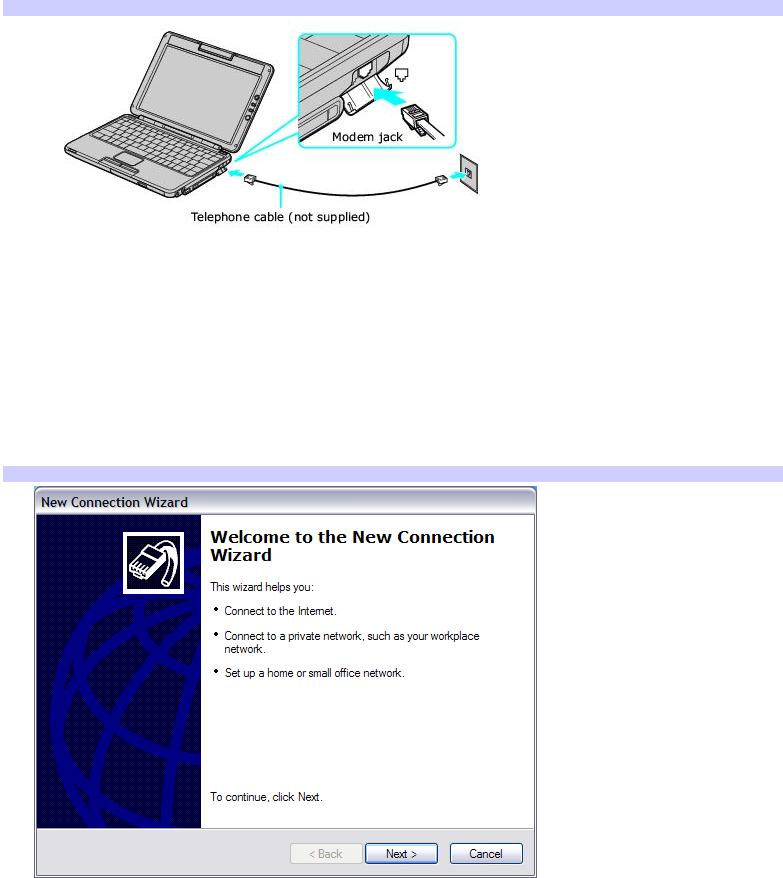
Setting up a dial-up Internet connection
Before you can connect to the Internet, you need to connect your computer to a telephone line via a telephone cable (not supplied). Once you set up your telephone cable, you're ready to connect to the Internet.
To connect a telephone cable
1.Locate the Modem jack on your computer. For location information, see "Locating Ports and Controls" in the "Setting Up" chapter of your printed VAIO® Computer Quick Start.
2.Plug one end of the telephone cable into the Modem jack. Make sure it clicks into place.
3.Plug the other end into the wall jack.
Connecting a Telephone Cable
 Your computer does not work with party lines, cannot be connected to a coin-operated telephone, and may not work with multiple telephone lines or a private branch exchange (PBX). Some of these connections may result in excess electrical current and could cause a malfunction in the internal modem.
Your computer does not work with party lines, cannot be connected to a coin-operated telephone, and may not work with multiple telephone lines or a private branch exchange (PBX). Some of these connections may result in excess electrical current and could cause a malfunction in the internal modem.
If you connect a telephone cable coming through a splitter, the modem or connected device may not work properly.
To set up a dial-up connection to the Internet
1.Connect your computer to a telephone line. See To connect a telephone cable for more information.
2.Click Start, point to All Programs, Accessories, Communications, and click New Connection Wizard. The New Connection Wizard appears.
New Connection Wizard
Page 27
3.Click Next. If the Location Information dialog box appears, follow the on-screen instructions.
4.If it is not already selected, click to select Connect to the Internet, and click Next.
5.Follow the on-screen instructions.
Page 28
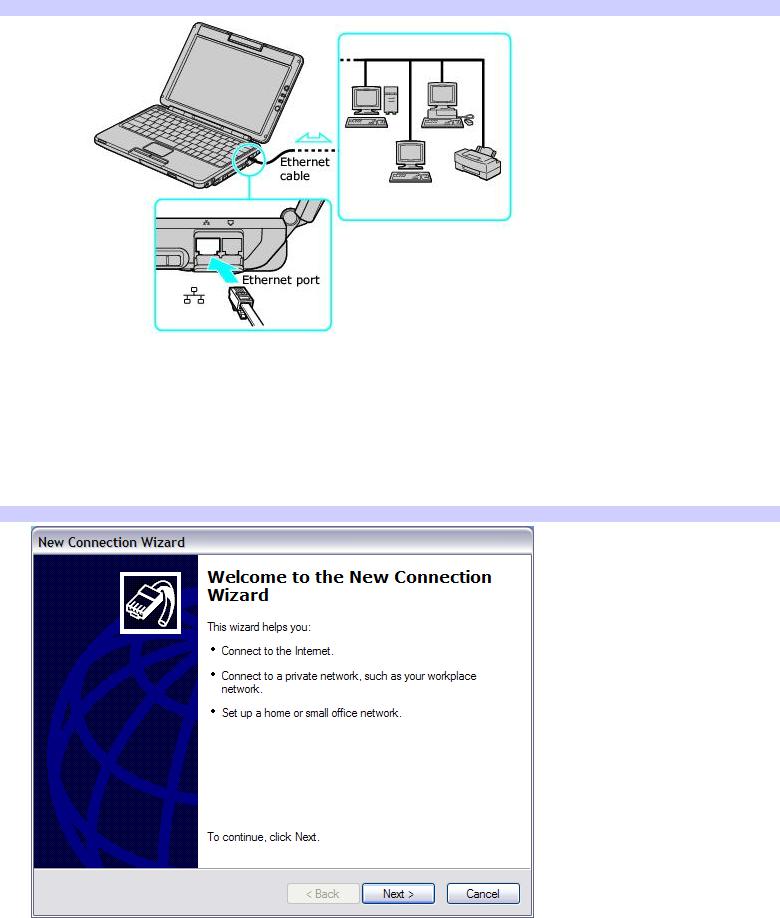
Setting up an Ethernet Internet connection
Your computer accommodates both 10BASE-T and 100BASE-TX Ethernet connections, with data transfer speeds of between 10 and 100 Mbps.
To connect an Ethernet cable
1.Locate the Ethernet port on your computer. For location information, see "Locating Controls and Ports" in the "Setting Up" chapter of your printed VAIO® Computer Quick Start.
Connecting an Ethernet Cable
2.Plug one end of the Ethernet cable into your computer's Ethernet port  and the other into the network connection.
and the other into the network connection.
To set up an Ethernet connection to the Internet
1.Connect your computer to a network connection.
2.Click Start, point to All Programs, Accessories, Communications, and click New Connection Wizard. The New Connection Wizard appears.
New Connection Wizard
Page 29
3.Click Next. If the Location Information dialog box appears, follow the on-screen instructions.
4.If it is not already selected, click to select Connect to the Internet, and click Next.
5.Follow the on-screen instructions.
Page 30
